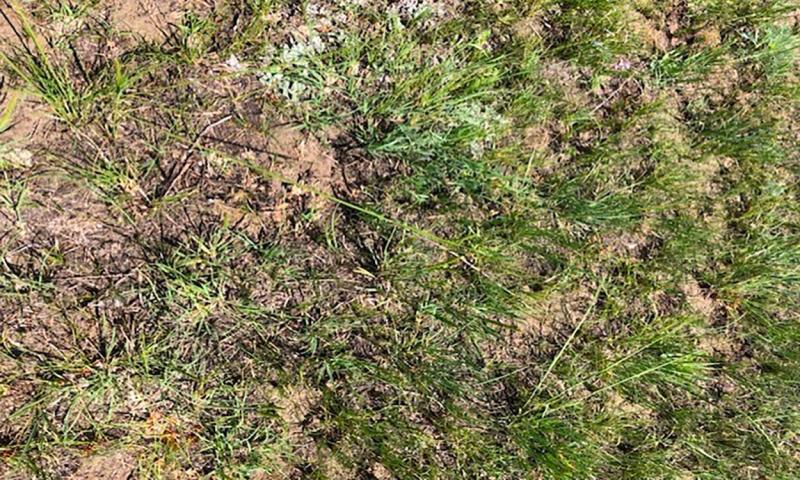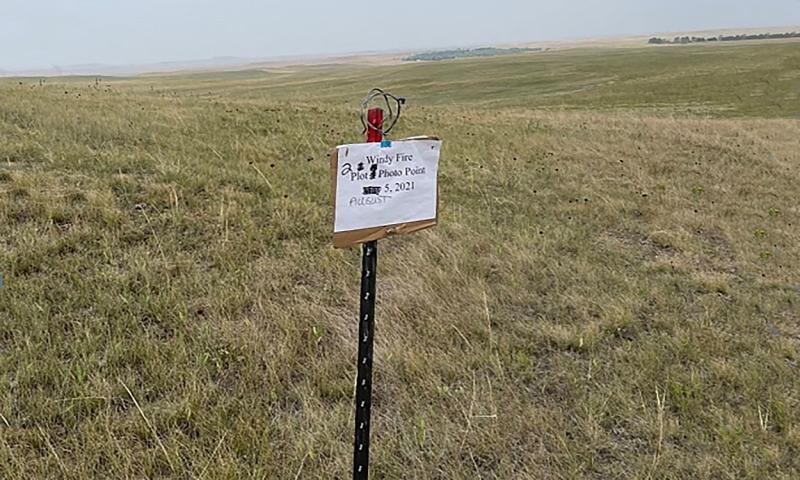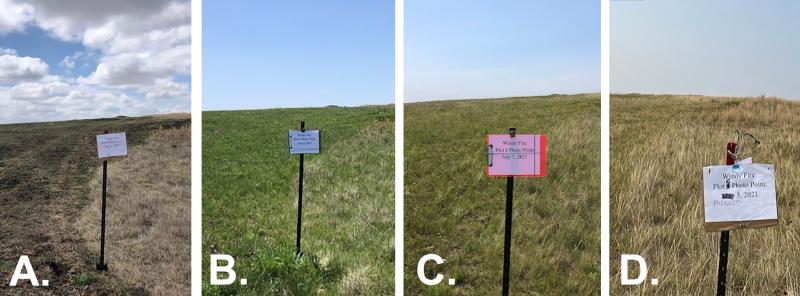
Originally written by Jessalyn Bachler, former SDSU Extension Range Field Specialist.
Dormant season wildfires can lead to devastating ecological effects on rangelands, such as loss of livestock and wildlife, critical habitat and forage. Native rangelands have evolved with wildfire and are able to tolerate burn impacts, and they generally quickly recover under normal circumstances and environmental conditions. Two of the main environmental conditions that drive post-wildfire rangeland recovery include health of the rangeland ecosystem prior to the wildfire and climatic variables, such as precipitation or drought after the fire event.
Introduction
In 2021 areas of South Dakota were stricken with prairie wildfires that stemmed from a dry, open winter, followed by a spring and summer with very little moisture. Dry conditions took a toll on forage production, making the loss of grazing land due to wildfire especially concerning to many livestock producers, leading those affected by wildfires to ask, “Will I be able to graze the pastures that burned this season, or do I need to destock and let my land recover?” To address this and related issues, South Dakota State University (SDSU) Extension, in partnership with South Dakota Natural Resource Conservation Service (NRCS), created an applied, producer-based study to examine the effects of dormant season wildfires that occurred in Perkins County in northwestern South Dakota.
Background

Two dormant season wildfires occurred in early 2021 (specifically January and March) in Perkins County, encompassing over 25,000 acres of range, pasture, hay and crop land. With little snowfall or moisture prior to or after the wildfires, much of the soil was bare and exposed to erosion for several months. Wind and water erosion were a major concern, and several high-wind events moved soil particles to neighboring land (Figure 1). Our study examined the impacts of these dormant season wildfires, erosion on forage production and overall rangeland recovery post-wildfire.
Project Setup
The goal of the project was to help producers make informed decisions about grazing management after dormant season wildfires that occurred within a larger period of drought in northwest South Dakota. Photo points, forage production and plant species composition changes were analyzed to evaluate overall rangeland recovery and health. Several plot points were established on wildfire-affected rangelands and were monitored monthly throughout the growing season (May, June, July and August). Plot points were set up to straddle the fire line and on burned-only areas. The fire line points compared burned versus unburned changes. The burned-only without a control were used to compare long-term grazing management techniques, such as season-long grazing and rotational grazing. In-field soil tests, including water infiltration and aggregate stability were used to quantify soil erosion.
"The goal of the project was to help producers make informed decisions about grazing management after dormant season wildfires that occurred within a larger period of drought in northwest South Dakota."
Project Results and Impact

On the burn line plot points, initial results indicate that burned sites had lower forage production (about 600 lbs. per acre) when compared with unburned sites. However, desirable native plant species composition tended to favor the burned sites, as a decreased amount of invasive grass species (primarily Kentucky bluegrass) was recorded. A notable difference between burned and unburned areas was the lack of litter protecting the soil on the burned sites (Figure 2). It was also noted that forb species appeared to favor the burned areas. When the in-field soil tests were performed, little difference was seen for infiltration rates between burned and unburned areas. However, aggregate stability tests resulted in one burned site (that had excessive soil erosion) showing much weaker aggregate stability when compared to other burned sites. There was little difference for aggregate stability among all other sites (burned or unburned).

Previous management likely also affected rangeland recovery, namely bare ground and plant species composition. Higher percentages of bare ground were seen on pastures that were traditionally season-long grazed when compared with pastures that were in a grazing rotation. Season-long grazed pastures tended to have a plant community more dominated by native short grasses, such as buffalograss and blue grama (along with the introduced Kentucky bluegrass), while the rotationally grazed pastures tended to have more mid-size grasses, such as native western wheatgrass (along with introduced Kentucky bluegrass). These findings indicate that proper grazing management prior to a wildfire has an influence on range recovery after the fire.
Overall, the affected rangelands recovered well. The burn line was hardly noticeable by the end of the growing season as seen in Figure 3. Figure 4 depicts the monthly recovery from May through August 2021.
Despite the dormant season wildfires occurring during drought conditions, all sites recovered and produced adequate forage for livestock grazing the following fall (2021), providing much-needed relief for South Dakota producers. Rangeland recovery is ongoing; forage production will be monitored in the years to come, and it is our intention to report those results.

Acknowledgments
Thank you to support from personnel from both SDSU Extension and SD NRCS, as they played a large role in helping set up the project and supporting ongoing research.
- Ryan Beer, NRCS Area Rangeland Management Specialist (Bison)
- Pete Bauman, SDSU Extension Range Field Specialist (Watertown)
- Krista Ehlert, SDSU Extension State Range Specialist (Rapid City)
- Stan Boltz, NRCS Regional Soil Health Specialist (North Dakota and South Dakota)
- Tanse Herrmann, NRCS State Grazinglands Soil Health Specialist (South Dakota)